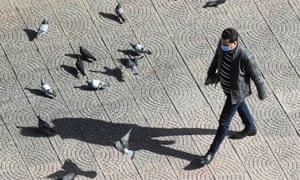
In normal times Paris’s famous Place du Tertre – the “artists’ square” – is packed with tourists and visiting out-of-towners, even on a chilly January afternoon. In the time of coronavirus, however, the square, home to painters, portraitists, caricaturists and silhouette artists, is almost entirely deserted.
The cafes and brasseries are closed, their terrace chairs chained up, and only a handful of the more optimistic artists have braved the cold for a few hours before the 6pm curfew kicks in:
New Zealand records first Covid community case in two months
A 56-year-old woman has tested positive for Covid-19 in New Zealand, after being released from government managed isolation following two negative tests.
It is the first community case in the country since 18 November. It came as neighbouring Australia, which had also been hailed for its success in battling coronavirus until a recent spate of community cases, recorded zero cases of local transmission across the country on Sunday.
The woman in New Zealand who tested positive arrived in Auckland on 30 December after travelling in Spain and the Netherlands for four months. She returned two negative Covid tests while staying in government-managed isolation at the Pullman hotel, having arrived from London.
The woman was released from the Pullman on 13 January and travelled around south Northland with her husband, visiting as many as 30 locations, including popular holiday spots, AirBnbs, and shops.
In the last week, the woman began experiencing very mild symptoms, including muscle aches. Having returned two negative tests the woman did not suspect Covid-19 until she returned a positive test late on Saturday.
Director general of health Dr Ashley Bloomfield said the woman and her husband were now in self-isolation in their home south of Whangarei, and the woman did not require hospital care.
Updated
at 12.46am EST
In the UK, ministers are at the centre of an explosive row over their failure to protect workers from Covid-19 as the Observer reveals the largest workplace outbreak of the virus has taken place at a top government organisation.
More than 500 cases have been recorded at the Driver and Vehicle Licensing Agency’s offices in Swansea, where employees claim people with symptoms were encouraged to return to work while vulnerable workers have had requests to work from home turned down.
The revelation places the transport secretary, Grant Shapps, under pressure to explain how such an outbreak could have happened in an agency where the strictest workplace rules are supposed to apply:
In December, the UK reported a Covid-19 variant of concern, commonly referred to as the B117 variant, which appeared to be more transmissible. Since then, scientists have established that B117 is somewhere between 50% to 70% more transmissible than other variants. If more people are getting sick, there is more pressure on health systems, and in the UK health services are so overloaded a country-wide lockdown has been enforced.
While many scientists say B117 does not appear more deadly, researchers on the UK government’s New and Emerging Respiratory Virus Threats Advisory Group found it may increase the death rate by 30% to 40%, though their sample size was small and they said more research is needed. With B117 now detected in more than 50 countries, understanding the variant is urgent.
But other variants of concern have also been identified, including in California, South Africa and Brazil.
So exactly what is a variant, and how many are there? And why are some variants of more concern than others?
Answers at the link below:
And what a year it has been. In just over a month’s time, I will have been liveblogging international developments in the coronavirus pandemic for eight hours a day, every day on the global blog – which has been running non-stop around the world almost uninterrupted for more than a year.
This time last year, I was living in Beirut, having just returned from reporting on the bushfires in Australia.
Where were you at the end of January 2020? Let me know on Twitter @helenrsullivan.
Updated
at 8.58pm EST







